- Return to main Featured Ranch Archives index
McClure Farm
March 2000
The McClure hay operation on Moccasin Wallow Rd. in Parish is part of a larger enterprise owned by Mr. Dan C. McClure of Bradenton, Florida. The enterprise includes a tomato production farm (West Coast Tomato Operation) and a 1000-head cattle ranch. Both the ranch and hay businesses are managed by an innovative young producer, Mr. Clay Newsome (Livestock Production Manager).
"When I took over the management approximately three years ago, the ranch was virtually idle with very little improved pastures. Three years ago, I stared pasture renovation with Ona stargrass and a lot of advice from the Range Cattle Research & Education Center at Ona. Today, I can boast of nearly 700 acres of Ona stargrass hayfields and another 300 acres divided between Floralta limpograss, Florico stargrass and Florakirk bermudagrass. My target is maintain the 1,000 acres of hayfields in a 5-6 years rotation with tomato farming".
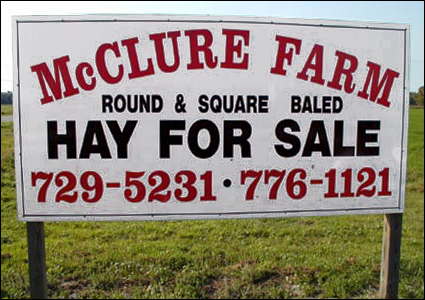
Pasture establishment follows a tomato crop. After repeated disking to obtain a clean seed bed, Mr. Newsome sprigs fields with freshly harvested planting material at 1,500 pounds per acre. He covers the sprigged material with a home-made crimper (designed according to IFAS specifications) immediately after broadcast to prevent material from drying. Then Clay ensures that the soil is packed firmly around planted material.
A flood irrigation system from the previous tomato operation is at a stand-by to ensure moisture availability and successful establishment even when the weather turns dry. Water for the irrigation system is provided inexpensively from the effluent of Palmetto City sewage treatment system.
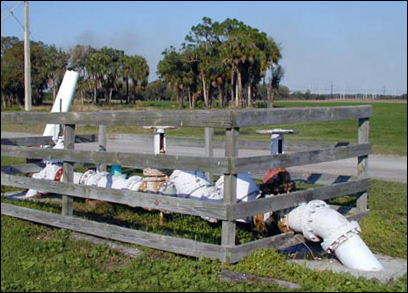
Main pipeline for the effluent irrigation system.
Fertilization follows IFAS recommendations. Mr. Newsome also applies a complete fertilizer to a hayfield after each cutting to ensure quick regrowth and a quality product. Machinery and equipment are shared between tomato and hay farming to improve efficiency. Grasses are cut at 4 to 5 weeks regrowth in order to obtain high quality forage and cut material is normally baled one day after mowing. Square bales for the horse and dairy markets are baled at 6 to 10% moisture and stored in a shed. Round bales are made for the beef cattle market. Forage yield per cut averages about 110 square bales or 7.5 round bales/A. At 10% moisture content, forage production amounts to 2.5 ton/A of dry matter containing 12 to 15% crude protein and 55 to 60% TDN.
Mr. Newsome has already won over the soul and hearts of most livestock producers in Manatee, Hillsborough and neighboring counties with his good quality hay. The greenery scene of his hayfields is also an aesthetic beauty to watch.
In recognition of the farm's remarkable progress at hay production operation , the South Florida Beef and Forage Program organized a hay Production Field Day activity on McClure Farms last fall. Clay presented the details of his grass variety selection, establishment, fertilization, irrigation, insect pest control, harvesting, processing and storage practices to the group of producers in attendance. He provided a tour for the group to examine the hay fields.
Hot, humid weather with frequent rain occurs during peak summer grass growth, making hay production difficult in Florida. Therefore, some hay fields on the farm are partially grazed during inclement weather in summer. When weather conditions permit, the grass must be harvested one day, dried and baled the next day. A roller-conditioner system is used to improve drying time over the standard mower but it is the experience of RCREC that the use of a flail conditioning system is even better. Regardless of the mechanical hay conditioning system used, there are major grass differences in drying time. Crops with large stems such as Floralta limpograss take several days longer to dry compared with fine stemmed grasses such as Florakirk and Florona. After baling, hay is protected from the elements of weather to avoid losses by storage in barns or under plastic covers.
Another forage conservation technology that has been developed to overcome the adverse humid summer conditions is the plastic wrapper for round bale silage or the plastic tube for chopped silage. The wrapper or tube method makes it possible to harvest and store forage immediately after cutting or up to 4 hours of wilting in the field. Round bales are separately wrapped tightly and chopped material tightly packed to exclude air. Several hay wrapping machines and plastic materials are available on the market. The plastic you select should be strong to resist punctures from stubble, rocks, etc., and withstand ultraviolet radiation (sun) without disintegrating. The white plastics film reflects sun rays and prevent overheating (110+ oF) during fermentation.
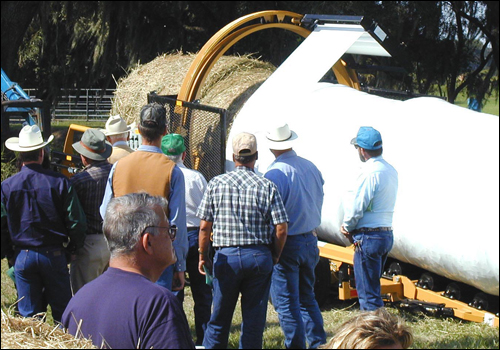
Close-up of Hay Wrapping Demonstration
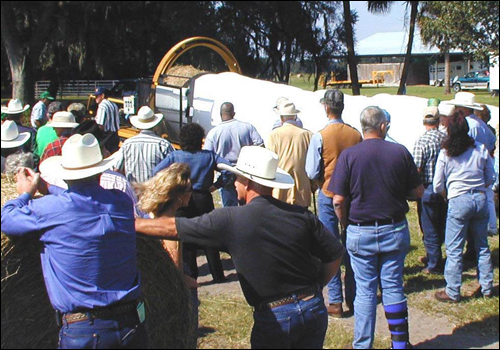
Hay Field Day Participants Watching Demonstration of Hay Wrapping Process
A hay wrapper machine was exhibited at McClure Farm by Rite-Away company from Samson, Alabama to demonstrate the updated hay wrapping process. Additionally, Mr. Dan C. McClure himself took time off his busy schedule and joined Mr. Clay Newsome to provide a first class educational tour. We salute Mr. McClure and Mr. Clay Newsome for their foresight, for hosting the field day participants and above all for their leadership role in the hay business.
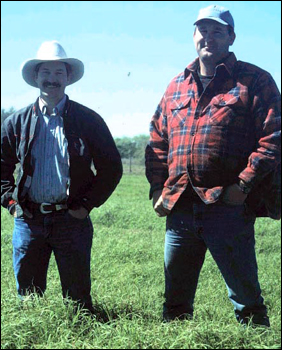
Doug Mayo, SFBFP Chairman & Clay Newsome, Livestock and Hay Production Manager in a hay field
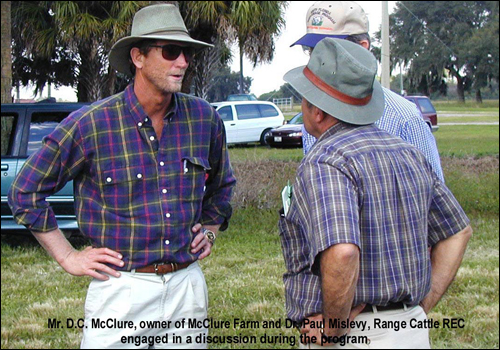
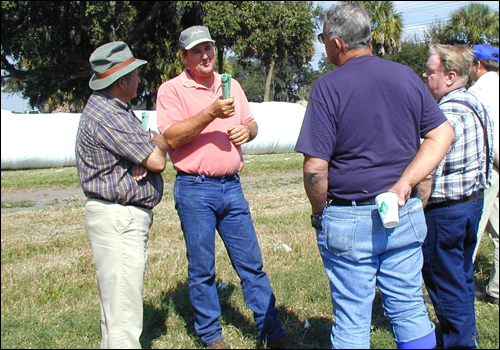
Dr. Paul Mislevy, Range Cattle Research & Education Center & Clay Newsome, Livestock and Hay Production Manager engaged in a discussion during the program

